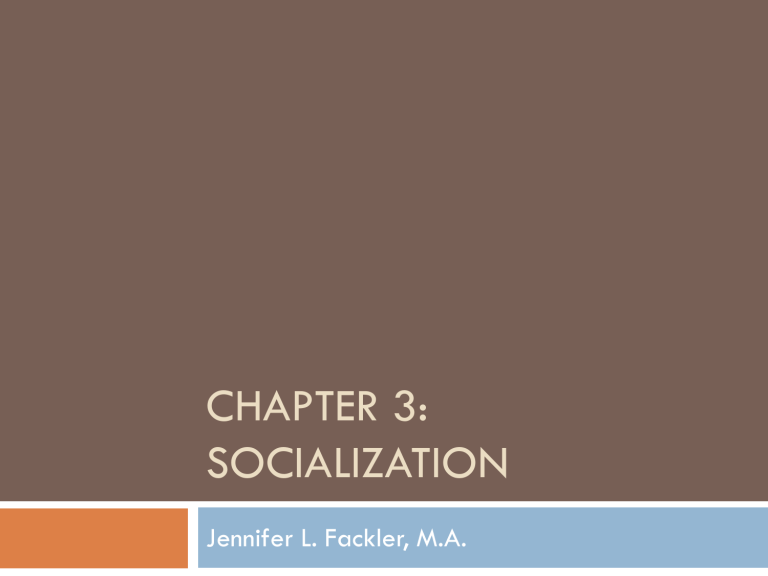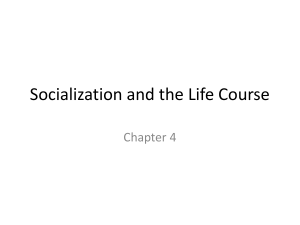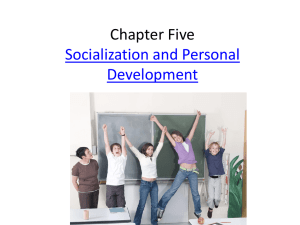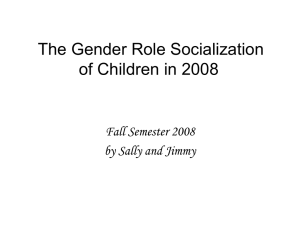
CHAPTER 3: SOCIALIZATION Jennifer L. Fackler, M.A. Social Experience The Key to Our Humanity Socialization Socialization – the complex, lifelong social experience by which people develop their human potential and learn culture Social experience is also the foundation of personality, a person’s fairly consistent patterns of acting, thinking and feeling. Human Development: Nature & Nurture Sciences Nature Social Sciences Nurture Biological Nature vs. Nurture Nature Darwin’s groundbreaking study of evolution led people to think that human behavior was instinctive. Nurture Biological explanations came under fire during the 20th century. Behaviorism – behavior is learned rather than instinctive (Watson) Biology is still important, but whether you develop your inherited potential depends on how you are raised. Nurture matters more in shaping human behavior because nurture is our nature. Social Isolation The Harlow Primate Studies (1962) This American Life Audio Clip (First 6m30s) Social Isolation Cutting people off from the social world is very harmful. The Harlow Primate Studies (1962) Complete Isolation Disturbed Development Passivity, Anxiety & Fear Artificial Mother Isolation Unable to Interact in a Group More Realistic Artificial Mothers = Slightly Better Could recover from up to 6 months of isolation, but suffered irreversible emotional & behavioral damage after 6 months. Conclusion: Primates benefit from closeness and are harmed by social isolation. Social Isolation Studies of Isolated Children (FeralChildren.com) Show the damage done by depriving human beings of social experience. Anna (1938) Isabelle (1930s-1940s) Isolated for 6 years. Displayed same non-responsiveness. Made a nearly full recovery due to an intensive learning program. Genie (1970) Almost no human contact until 5 years of age. Could not laugh, speak or even smile. Completely unresponsive. Exhibited some recovery, but developed slowly. Isolated until age 13. Recovered physically, but remains mentally impaired. Critical Review Illustrates the importance of social experience in personality development. Human beings can recover from abuse and short-term isolation, but there is a limit. Understanding Socialization Freud’s Elements of Personality Id – represents the human being’s basic drives Unconscious and demands immediate satisfaction; present at birth Society opposes the self-centered id. To avoid frustration, a child must learn to approach the world realistically. Ego – a person’s conscious efforts to balance innate pleasureseeking drives with the demands of society Ex: “No!” is the first word a child learns. Develops as we become aware of ourselves and realize we cannot have everything that we want. Superego – the cultural values and norms internalized by an individual Operates as our conscience, telling us why we cannot have everything we want. Begins to form as a child matures over time. Freud’s Elements of Personality Personality Development To the id-centered child, the world is a bewildering assortment of physical sensations that bring either pleasure or pain. As the superego develops the child leans the moral concepts of right and wrong. The id and superego remain in conflict, but in a welladjusted person, the ego manages these opposing forces. If conflicts are not resolved early in life, they may surface as personality disorders later on. Culture, in the form of the superego, represses selfish demands, forcing people to look beyond their own desires. Sublimation – redirects selfish drives into social acceptable behavior Result of the competing demands of self and society. Ex: Marriage Sex, Others? Freud’s Elements of Personality Critical Review Difficult to test scientifically. Influenced everyone who later studied human personality. Of special importance to sociology are his ideas that we internalize social norms and that childhood experiences have a lasting impact on our personalities. Piaget’s Theory of Cognitive Development Studied human cognition, which is how people think and understand. 4 Stages of Development: Sensorimotor Stage – experience the world only through their senses; first 2 years of life Preoperational Stage – first use language and other symbols; 2-6 years of age Concrete Operational Stage – first see connections in their surroundings; 7-11 years of age Ex: Blocks Together vs. Apart – Bigger? Ex: Liquid in Tall/Thin vs. Short/Round Container – More? Formal Operational Stage – think abstractly and critically; 12+ years of age Critical Review Saw the mind as active, creative, and continually developing. Acknowledged the role of both biological maturation and social experience. Kohlberg’s Theory of Moral Development Built on Piaget’s work to study moral reasoning, which is how individuals judge situations as right or wrong. 3 Stages: Preconventional – young children; rightness amounts to what feels good to me Conventional – teenagers; lose some selfishness and learn to define right and wrong in terms of what pleases parents and conforms to cultural norms Postconventional – people move beyond society’s norms to consider abstract ethical principles Critical Review Does this model apply to people in all societies? All subjects were boys. Gilligan’s Theory of Gender & M.D. Compared the moral development of girls and boys. Conclusion: Boys and girls use different standards of rightness. Boys: Justice Perspective – rely on formal rules to define right and wrong Girls: Care & Responsibility Perspective – judge a situation with an eye toward personal relationships Impersonal rules dominate men’s lives in the workplace. Personal relationships are more relevant to women’s lives as mothers and caregivers. Example: Stealing Critical Review: Does nature or nurture account for the differences? Per Gilligan: Cultural Conditioning Erikson’s 8 Stages of Development Explained socialization as a series of challenges. Stage 1 – Infancy: The Challenge of Trust Stage 2 – Toddlerhood: The Challenge of Autonomy Learn skills to cope with the world in a confident way. Stage 3 – Preschool: The Challenge of Initiative Must establish a sense of trust that their world is a safe place. Family is key. Learn to engage their surroundings. Stage 4 – Preadolescence: The Challenge of Industriousness Enter school, make friends, and strike out on their own more. Erikson’s 8 Stages of Development Stage 5 – Adolescence: The Challenge of Gaining Identity Struggle to establish their own identity. Stage 6 – Young Adulthood: The Challenge of Intimacy Identify with others, but want to be unique. Must form and maintain intimate relationships. Requires a balance between the need to bond and the need to have a separate identity. Stage 7 – Middle Adulthood: The Challenge of Making a Difference Want to contribute to the lives of others (family, work, world). Erikson’s 8 Stages of Development Stage 8 – Old Age: The Challenge of Integrity Hope to look back on what they have accomplished with a sense of integrity and satisfaction. Critical Review Views personality formation as a lifelong process that involves many factors. Failure at one stage doesn’t necessarily mean you can’t progress. Not everyone faces these challenges in the same order. Would people in other cultures and times define a successful life in Erikson’s terms? Mead’s Theory of the Social Self Theory of Social Behaviorism – explains how social experience develops an individual’s personality The Self – part of an individual’s personality The self develops only with social experience. Social experience is the exchange of symbols. Mead’s Theory of the Social Self Imagining the Situation from the Other’s POV Taking the Role of the Other - seeing ourselves as others see us All social interaction requires this! Understanding intention requires imagining the situation from the other’s point of view (aka taking the role of the other). We find meaning by imagining people’s underlying intentions. Animal responds to WHAT YOU DO vs. human responds to WHAT YOU HAVE IN MIND. Also allows us to anticipate how others will respond to us. The Looking-Glass Self – a self-image based on how we think others see us (Cooley 1902) Others are a mirror (aka looking glass) in which we can see ourselves. What we think of ourselves depends on how we think others see us. Mead’s Theory of the Social Self Self Has 2 Parts: The I & The Me By taking the role of the other, we become self-aware. “I” – active side of the self that operates as subject, being active and spontaneous; subjective (self-image) “Me” – the objective side of the self that operates as an object and is formed by the way we imagine others see us; objective (self-awareness) All social experience has both components: we initiate the action (I) and then continue it based on how others respond (me). Mead’s Theory of the Social Self Development of the Self – the key is learning to take the role of the other Imitation – infants Play – young children Games – older children Involves assuming roles modeled on significant others, people – like parents – who have special importance for socialization Requires a child to take the roles of several others at once and change roles when needed. Generalized Other – adults – widespread cultural norms and values we use as a reference in evaluating ourselves Everyday life demands that we see ourselves in terms of cultural norms as any member of our society might. Building on Social Experience George Herbert Mead described the development of the self as a process of gaining social experience. That is, the self develops as we expand our capacity to take the role of the other. Mead’s Theory of the Social Self Self Across the Life Course As life goes on, the self continues to change along with our social experiences. Critical Review: Completely social, allowing no biological element. Agents of Socialization The Family For many, most important socialization agent. Family has to teach children skills, values, and beliefs. Some learning is intentional, but some comes from the type of environment adults create. Parents give children a social identity, including race & class. Race is complex because societies define race in different ways. Class position shapes a child’s personality, affecting how others see them and how they see themselves. Impacts what parents expect of their children. Lower: Obedience & Conformity Upper: Good Judgment & Creativity Upper Class Children Extensive Leisure Activities Cultural Capital, which advances learning and creates confidence. All parents act in ways that encourage their children to follow in their footsteps. The School Enlarges children’s social world by introducing people who have different backgrounds. First understand the importance of factors like race and class position. Schools help socialize children into gender roles. Boys: Physical Activities & Outdoor Time; Aggressive Girls: Housekeeping Tasks; Quiets & Well-Behaved Upper Class Children Better Experience in School Schools informally teach a hidden curriculum. Likely to cluster in homogenous playgroups. Example: Spelling Bee Spelling & Winning/Losing Other examples? Children’s first experience with bureaucracy. The Peer Group Peer Group – a social group whose members have interests, social position, and age in common Escape the direct supervision of adults. Learn how to form relationships on their own. Offer a chance to discuss interests that adults may not share or permit. Ex: Hannah Montana or Sex; Others? Attitudes/interests of the young and old often differ due to a “generation gap.” Importance typically peaks during adolescence. Anticipatory Socialization – learning that helps a person achieve a desired position Ex: Stylish & Trendy Clothes Popular Crowd; Others? The Mass Media Mass Media - the means for delivering impersonal communications to a vast audience Introduce us to ideas and images that are new and different. Have an enormous effect on our attitudes and behavior. TV in the US Trends: Average household has at least one set turned on for 8 hours/day. People spend ~1/2 their free time watching TV. Youngsters (8-18 yo) average 6.5 hours a day “consuming media,” including almost 3 hours of TV. TV Passive, Less Fit, Less Imaginative Kids (per studies) Television Ownership in Global Perspective Television is popular in high- and middle-income countries, where almost every household owns at least one TV set. Source: U.S. Census Bureau (2008) and International Telecommunication Union (2008) The Mass Media TV in the US (Continued) Violence: Public is concerned about violence in television and films. Does watching sexual or violent programming harm people? How? Does it cause violent or sexual behavior? How? Ex: Scream & Other Horror Movies Ex: Can TV get you pregnant? More Important Q: Why do the mass media contain so much sex and violence in the first place? The power of media to shape how we think remains highly controversial. Agents of Socialization Critical Review Other Agents of Socialization: Workplace, Religious Organizations, Military, Social Clubs Sometimes what we learn from the various agents of socialization is in conflict. Ex: Family Drugs are Bad; Media & Peers Drugs are Cool; Others? Socialization is a complex balancing act as we absorb information from different sources. As we sort and weigh the info we receive, we shape our own distinctive personalities. Socialization & The Life Course Read pages 84-89. The Graying of America The Graying of U.S. Society The proportion of the U.S. population over the age of 65 tripled during the last century. The median age of the U.S. population has now passed 35 years and will continue to rise. Source: U.S. Census Bureau (2008). Resocialization Total Institutions Total Institution – a setting in which people are isolated from the rest of society and controlled by an administrative staff Experienced by more than 2M people in the US. Typical Examples: Prisons & Mental Hospitals Goffman (1961) – 3 Characteristics of T.I.s: Staff members supervise all aspects of daily life, including where residents eat, sleep, and work, Life is controlled and standardized, with the same food, uniforms, and activities for everyone. Formal rules dictate when, where, and how inmates perform their daily routines. Total Institutions Purpose: Resocialization – efforts to radically change an inmate’s personality by carefully controlling the env’t Institution becomes people’s entire world, making it easier for the staff to bring about personality change – or at least obedience. Two Part Process: Affect people in different ways. Break down existing identity. Build a new self using rewards & punishments. Rehabilitated or Recovered Minimal Change Hostile & Bitter Institutionalized – lacking the capacity for independent living after having been in an institution Alcatraz Booklet & Zimbardo’s Prison Experiment Discussion Questions As you moved through your childhood and adolescence, how did the relative importance of your family, school, peers, and the mass media as agents of socialization change? How would you account for these changes? What ethical issues prevent the isolation of humans for research purposes? Do these same issues arise when conducting this type of research with animals? What are common themes in the ideas of Freud, Piaget, Kohlberg, Gilligan, Mead, and Erikson? In what ways do their theories differ? Thinking About Diversity on Page 90 (Development of Self In HS) Controversy & Debate on Page 91 (Are We Free?) Conclusion Social experience is the key to our humanity. Humans need social experience and isolation is harmful. There are many theories of socialization: Freud, Piaget, Kohlberg/Gilligan, Mead, & Erikson. There are a variety of agents of socialization including family, school, peer groups, the mass media, and others. Sometimes we attempt to resocialize people within total institutions. Visual Summary on Pages 93-94 Review Questions on Page 95 Any questions?




